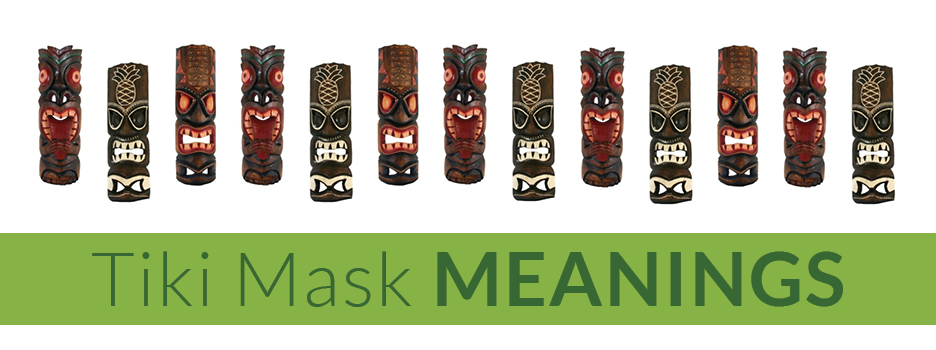
Are you interested in the mythical, mysterious and exotic? Do you love the idea of decorating your backyard, outdoor event, resort, hotel, park or other venue with the authenticity, majesty and tropical allure of symbolic decor that evokes the ancient mystery of the Hawaiian and Polynesian Islands?
If exotic and tropical is the type of aesthetic you’re looking for to make your property stand out, Tiki masks might be the perfect decor choice for you. Natural, wooden and hand-carved with unique personalities and faces brimming with symbolism, Tiki masks don’t just add whimsical elements to your tropical theme — they add meaning, history and authenticity reminiscent of rich island culture.
Jump To Sections:
- What Are Tiki Masks?
- How Are Tiki Masks Made?
- History of Tiki Masks
- Tiki Mask Meanings and Uses
- The Tiki Gods
- Modern Tiki Culture
- Choose Your Tiki Masks at Forever Bamboo
With the right Tiki masks, you can instill your outdoor setting with a specific mood, blessing or symbol. If you want to channel strength and resilience, there’s a Tiki head that embodies it. If you’re aiming for luxury and sensuality, you can instill it into the atmosphere of your space with a Tiki head to match. If you’re hoping to promote merriment and lightheartedness, you can pick a Tiki face to do that. No matter your venue, occasion, mood or aesthetic, Tiki heads can add authentic island decoration and cultural symbolism to legitimize your tropical theme. But how do you know the specific meaning of Tiki faces, which to choose and where to find them?
If you’re thinking about incorporating Tiki masks into your property’s decoration and want to know a little more about Tiki history, culture and what a Tiki symbolizes, this is the right place to begin. From their origins, history and cultural significance to their production methods and individual tiki mask meanings, we’ll tell you everything you need to know about the mysterious, vibrant, multifaceted faces you’re adding to your tropical theme.
What Are Tiki Masks?
Originally used in ancient Polynesian and Hawaiian culture, Tiki masks are hand-carved, wooden decorative masks intended to represent deities and bestow specific traits upon the setting in which they’re placed. Each mask represents a different purpose. For example, a Tiki mask in either a private home or a public setting might be thought to protect people from the dangerous threats and temptations of evil spirits, while another mask might bring about general good luck for those in the home. Some people even believe certain masks promote fertility of the family.
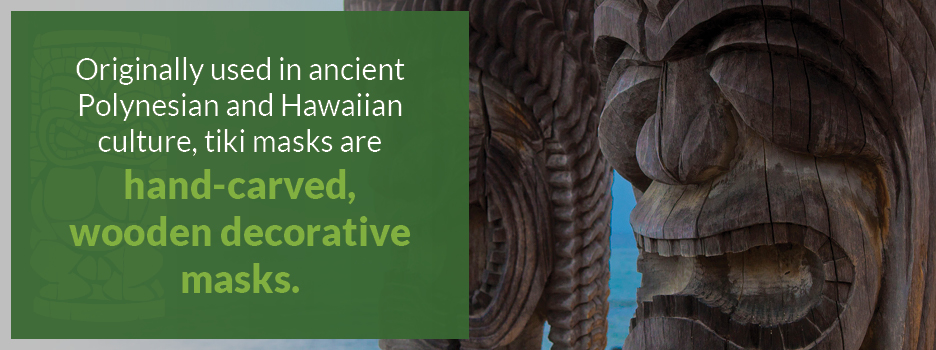
While some masks represent specific traits or charms, others specifically represent certain gods and are intended to stand in for the deity itself by instilling his or her traits into the household. One god might infuse the home and its members with strength and resilience, while another might promote peace and harmony in the family. Whatever god or trait each mask was meant to represent in ancient times, it provided the family and community with comfort, confidence and the assurance of protection against harm — and Tiki masks can still do so today.
Depending on its intended meaning, god or representative characteristic, each mask is carved with specific features to embody the identity of its meaning. A fully carved mask takes on the spirit and personality of its god or trait, becoming the personification of specific knowledge and power. Although they are called “masks” and were sometimes meant to protect and empower wearers, traditional Tiki masks were less frequently worn on the body than displayed as statues or decor in the home or the community.
How Are Tiki Masks Made?
Every tiki mask is hand-carved from wood, and no two masks are exactly alike. Because the facial features and specific expressions of the masks are so important to embodying the characteristic and the deities themselves to instill the spirits into the masks, Tiki mask makers must take extra care and carve each mask especially slowly and methodically, with special attention to detail. Requiring a significant mastery of skill, precision and artisanry, Tiki masks and statues occupy a place on the same artistic level as other pieces of historical fine art, such as sculptures and other cultural pieces.
To ensure the strongest build and therefore the strongest characteristics and deity embodiments, Tiki mask artisans use strong hardwood. After cutting workable blocks of wood, the craftsperson then carefully and lovingly carves each block into a unique Tiki face with a specific personality — complete with special designs and patterns. When the artist has finished carving the characteristics and details of the face, he or she then stains and finishes the wooden masks with a combination of lacquers, oils and waxes to make them shine and stand out. The masks might also be painted.
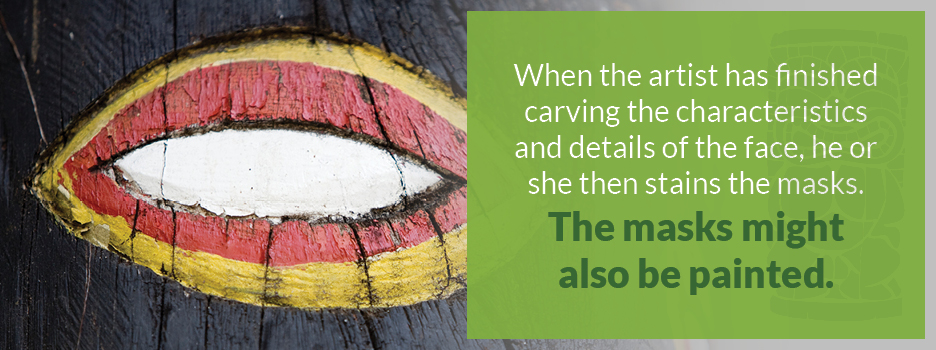
While traditional Tiki masks were often unpainted or finished with natural, earthy stain tones like tans and browns, modern Tiki faces used for decoration and enhancements today often incorporate bright, vibrant paint colors into their facial decorations. These bright, tribal hues and color combinations create an updated aesthetic and bold reinterpretation of tribal culture, while still keeping the historical essence of traditional Tiki statue forms and the deities they embody. Made from such high-quality materials and finished so carefully, Tiki masks can last a lifetime.
Because Tiki masks are typically used as a display piece more often than as bodily adornments, they are much larger than the average mask. Ancient, cultural Tiki faces — like the statues found on Easter Island — could be as large as 14 to 33 feet for community display purposes and to watch over the town. While some Tiki masks are as little as eight inches tall, most are at least a foot. Typical smaller Tiki masks meant for household and decor purposes might range from a couple to a few feet in height. At Forever Bamboo, we offer modern, hand-carved, authentic Tiki masks from 20 inches to five feet tall.
History of Tiki Masks
You now know a little about Tiki traditional masks and the process that goes into making them, but where did Tiki history begin, and what is the significance of the masks within Polynesian and Hawaiian island culture? Tiki masks originated with the Maori tribe, the indigenous Polynesian people of New Zealand. Spanning the Oceanic region, Polynesian tribes of aboriginal peoples include various interconnected cultures with similar belief systems and lifestyles, including the people of Australia and New Zealand, Hawaii, Easter Island and other Oceanic areas. Cultural beliefs, traditions, religious practices and symbols like Tiki masks carried across regions and tribes, looking similar in both aboriginal Polynesian and Hawaiian culture.
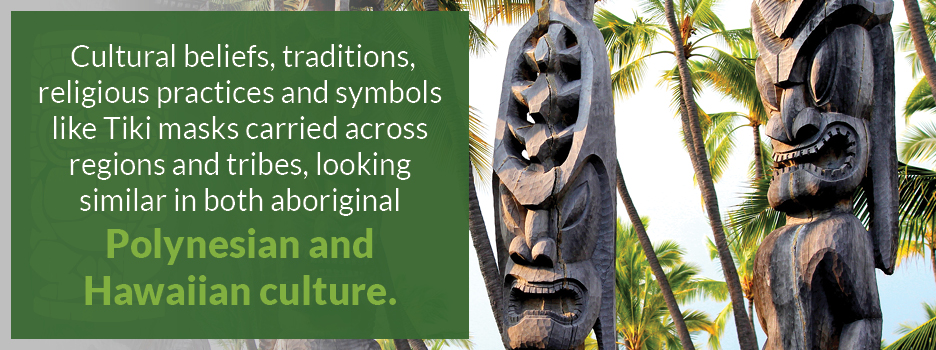
In the Maori tribe, which began in New Zealand and made its way to other Polynesian and Hawaiian islands, Tiki culture begins with Tiki, the first man. Believed to have been the creation of the god Kane, Tiki is often worshipped as a god because he was the first and only human being on Earth. Lonely, curious and craving companionship, Tiki wandered to a water pool, where — depending on the origin of the mythology — he either discovered or created the first woman, Marikoriko. Together, they created their son, Hine-kau-ataata, and began the human race.
Because of his mythological importance and vital role in the creation of their people, the Polynesians worshipped Tiki and began to create idols in his image. Over time, the Tiki mask and statue tradition grew to include a wide variety of gods, personas, traits and meanings, becoming integral to Polynesian culture and religion from about 1000 C.E. When the first Hawaiian inhabitants arrived from Polynesia thousands of years ago, they brought the tribal traditions and religious convictions of their many gods, as represented by Tiki masks, and so the tradition continued. Modern Tiki masks, as we incorporate them into our themes and decor, most often derive from the Hawaiian interpretations of traditional Tikis.
Tiki Mask Meanings and Uses
What does a Tiki head symbolize? Originally used to mark boundaries for sacred grounds and serve as religious idols, symbols and protectors in Polynesian culture, Tiki mask meanings have evolved over time and have only become richer, encompassing various deities, cultural traditions, meanings and uses. Here are the main ways Tiki masks have been used in history, along with their particular meanings.
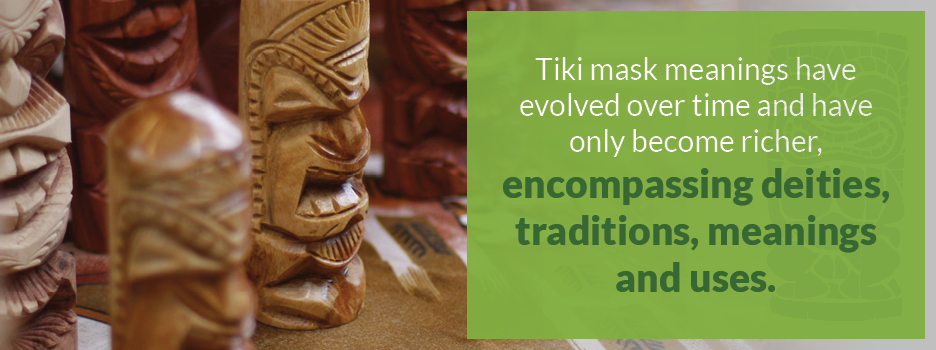
-
- Protection: Depending on the type of god or attribute they represented, Tiki heads could provide their users or wearers with special protection against evil spirits. A Tiki with strong, fierce facial features, for example, would provide individuals or families with embodiments of similar strength, resilience and positivity, protecting them from dangers that might come their way, preventing ill winds or unfortunate events from befalling them or instilling them with the power and majesty of the particular god the Tiki mask paid tribute to. Also, the Tiki mask itself could represent an idol, sentinel and manifestation of each god — so there would always be a higher power watching over the people nearby. Tiki heads could also protect and guard the borders of both villages and temples.
-
- Deity worship: In addition to using their Tiki statues and masks for the symbolism and literal practicality of protection, ancient Polynesian tribes paid tribute to the gods by using Tiki heads as idols for deity worship. In Hawaiian culture, the gods and the people shared a symbiotic relationship. When the people treated the land properly and offered acknowledgment and thanks to the gods, the gods rewarded the people with sustenance and bounty through fair weather, ample crop growth and verdant lands. This relationship was essential to the people’s culture and lifestyle, and erecting and displaying Tiki statues and masks was part of honoring the gods and communicating with them in one of their many forms by harnessing their mana — or power — in Tiki heads. Artisans would make specific Tikis to resemble specific gods and harness particular powers.
-
- Ancestor worship: Just like the tribal people worshipped the gods and carved Tiki heads in their likenesses, Tiki mask meanings could be intended for remembering and honoring tribal ancestors. Carved in remembrance of either the distinctive facial features or the symbolic characteristics of a beloved passed family member or tribal ancestor, the Tiki masks were thought to take on the spirit of the personality they were carved to embody. This tradition kept ancestors and loved ones close and unforgotten among the living people and in the community or the household, where they could watch over their descendants and protect the tribe.
- Good fortune: While the meanings of Tiki faces are always linked to a particular god, natural element or spiritual characteristic of the land, that doesn’t mean they’re exclusively for religious purposes. Often throughout history, Tiki heads were placed in the home or community for specific reasons other than worship. Motivations for erecting Tikis could include the desire for good fortune, the development of specific attributes or the hope of a specific event for the individual or family. For example, a certain Tiki mask in the home might promise overall favorable fortune and luck, to promise victory and bravery in battle pursuits, to bring bounty and good crops to the land or to bestow fertility upon a couple hoping for many children. Tiki masks promised tribal people many blessings and provided them with hope, comfort and stability.
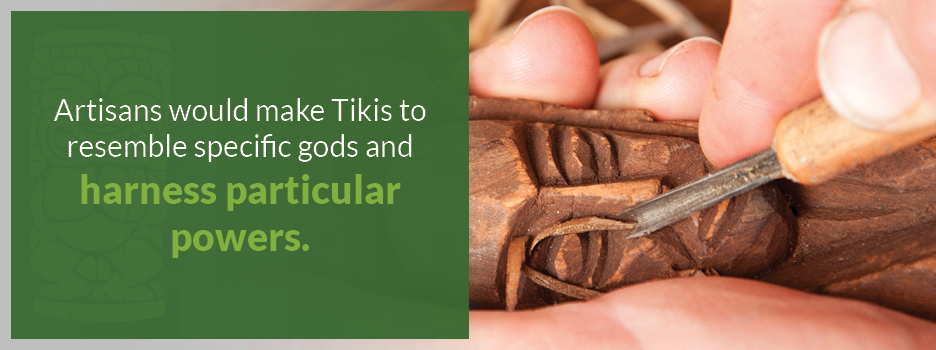
The Tiki Gods
The Hawaiians and Polynesians worshipped thousands of gods that pertained to natural elements, landmarks, plants and animals — and Tiki heads were a prominent factor in their lifestyle and the cultural importance of keeping the balance on their islands, acknowledging their lineage and thanking the deities who created and kept them.
In communicating with the gods, worshipping the land and ancestors and reaping the rewards of Tiki heads’ characteristics, the tribal peoples of Oceana and Hawaii typically crafted their unique Tiki heads after the images of four specific and prominent gods known as the Tiki gods. In Hawaiian culture especially, these gods represented the four elements in nature and had special characteristics. These are the four deities most traditionally represented in the styles and attributes of Tiki masks.
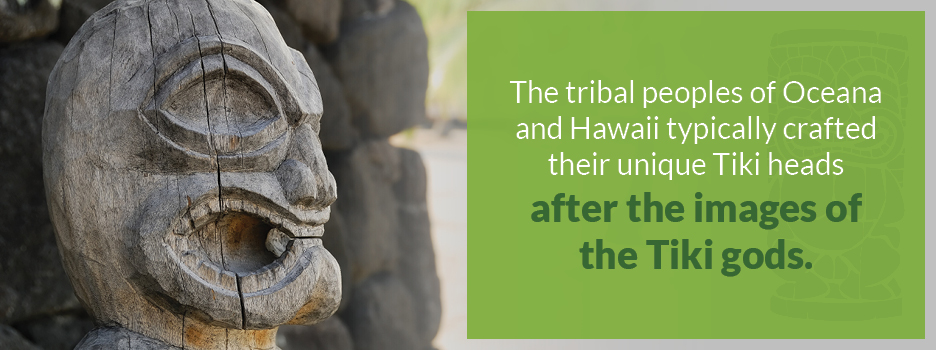
Ku: As one of the most prominent gods in Hawaiian mythology, Ku is one of the four great Tiki gods in history. The husband of the goddess Hina, he is the ancient god of war and a harbinger of strength. Even his name speaks to his fierceness and strong nature, as “ku” means “standing up” in the native language. Worshipped by many tribes, Ku is also known by variations of his name, including Ku-ka-ili-moku, meaning “the seizer of land.”
Ku is especially unique among the gods because some of his worship rituals included human sacrifice, which was never part of worship rituals for the other gods. He is also one of the most ancient — along with Lono, Kanaloa and Kane, he is an original, eternal, uncreated god responsible for providing light to the world, and he has always existed. In Tiki mask symbolism, his features lend the owners the strength, bravery, energy, motivation and focus of a great warrior.
Kanaloa: As the ancient god of the sea, Kanaloa is connected with the powers of the ocean, sailing, strength, water, springs and forces. Art often portrays Kanaloa alongside Kane as a complementary power — together, they symbolize the dual powers of wildness and taming. As the essential water element integral to island societies, Kanaloa is a major part of the Hawaiian mythology and lifestyle. His symbol is an image of a squid, and when represented in Tiki masks, he instills the characteristics of faith, hope and resolve, along with the property of cleansing.

Lono: Another one of the eternal, original gods, Lono is the ancient Tiki deity of peace and fertility. According to Hawaiian lore, he descended from a rainbow to the Earth below, bringing music, balance, peace, prosperity and bounty. Extremely important to the tribal lifestyle in terms of crops, human fertility and the home, Lono represents rain, plant growth and food, and ancient culture honored him through the annual festival of Makahiki, during which no tribes were allowed to participate in war or unnecessary work.
The twin brother of Kanaloa, Lono promotes peace, love and prosperity. When his image and characteristics are honored in the carving of a Tiki mask, he represents good fortune, strong family ties, happiness, love, fertility, strength in relationships and the seeking of higher knowledge. He is the most ancient of all the eternal gods.
Kane: Creator of the Earth, sky and heavens in ancient Hawaiian mythology, Kane is the father of many minor gods and the giver of gardens. Also known as Kane Hekili and Kane Hoalani, meaning “thunderer” or “lightning breaking through the sky,” Kane is considered a creative force, the father of the human race and all living things and a divine symbol of life in the natural world. The term “Kane” also means “man.” Kane is essential to tribal tradition, crop growth, planting and agriculture as a representation of life associated with the sun.
Legend has it that Kane possesses a tiny seashell that can transform into a large sailboat that will take its rider to whatever destination he wishes to reach. Such is Kane’s creative power. When used as inspiration for Tiki mask features, Kane embodies the traits of virtue, patience and consciousness, and provides security and safekeeping.
Modern Tiki Culture
Tiki masks have been in existence for thousands of years in the Polynesian and Hawaiian tribal cultures, but they didn’t gain prominence in the Western world until roughly the early 1900s. With the growing popularity of a Polynesian, South Pacific tropical look, bar owners, hotel managers and restaurant owners began to feature the tribal decor on their properties. Now, many cafes, clubs, restaurants, resorts, properties and parties incorporate them into their aesthetics to keep the culture alive and create a vibrant, tropical feel for their homes or customers.
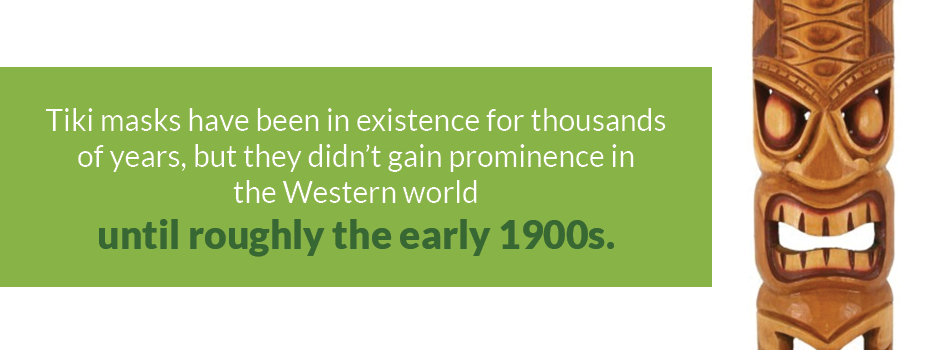
When you add your own unique Tiki masks to your home or business, they can represent whatever you desire. Use them as mere decorations to add a tropical flair to your aesthetic, or display them with special attention to their more symbolic meaning. You can even choose specific Tiki mask meanings to bring you good luck, good fortune and blessings for yourself and others!
Choose Your Tiki Masks at Forever Bamboo
Whether you’re enhancing your business, home, luau or event with a bright, tropical theme or hoping to bring optimal fortune and blessings to your settings, Forever Bamboo has the authentic quality and variety of Tiki masks you’re looking for. Incorporate our bold colors, unique faces and exciting patterns and designs into your backyard, Hawaiian Tiki party, tropical resort, island restaurant aesthetic, Tiki bar or other party or event. Our authentic Tiki masks are ideal for hanging on walls, decorating bamboo fences and placing on top of tables.
As the only tropical decor provider based on both the East and West Coasts, Forever Bamboo is dedicated to providing you with the quality experience and products you desire in decorating your setting. Offering free shipping on almost all our products, we are open seven days a week — our friendly, experienced staff is ready to help you with all your needs, preferences and questions, so feel free to reach out with any questions you may have. Complement your tropical theme with the unique character of traditional and modern Tiki masks by browsing our selection today. Try before you buy with a sample box! Place your order within 45 days of purchasing your samples and get $25 off. This makes your sample box FREE! Aloha!
Related Products & Information
- Tiki Masks
- 20 Inch Tiki Masks
- 40 Inch Tiki Masks
- Wooden Tiki Masks for Party Decorations
- Tiki Masks and Tropical Style
- Wooden Tiki Masks
- Wooden Tiki Masks for Home

